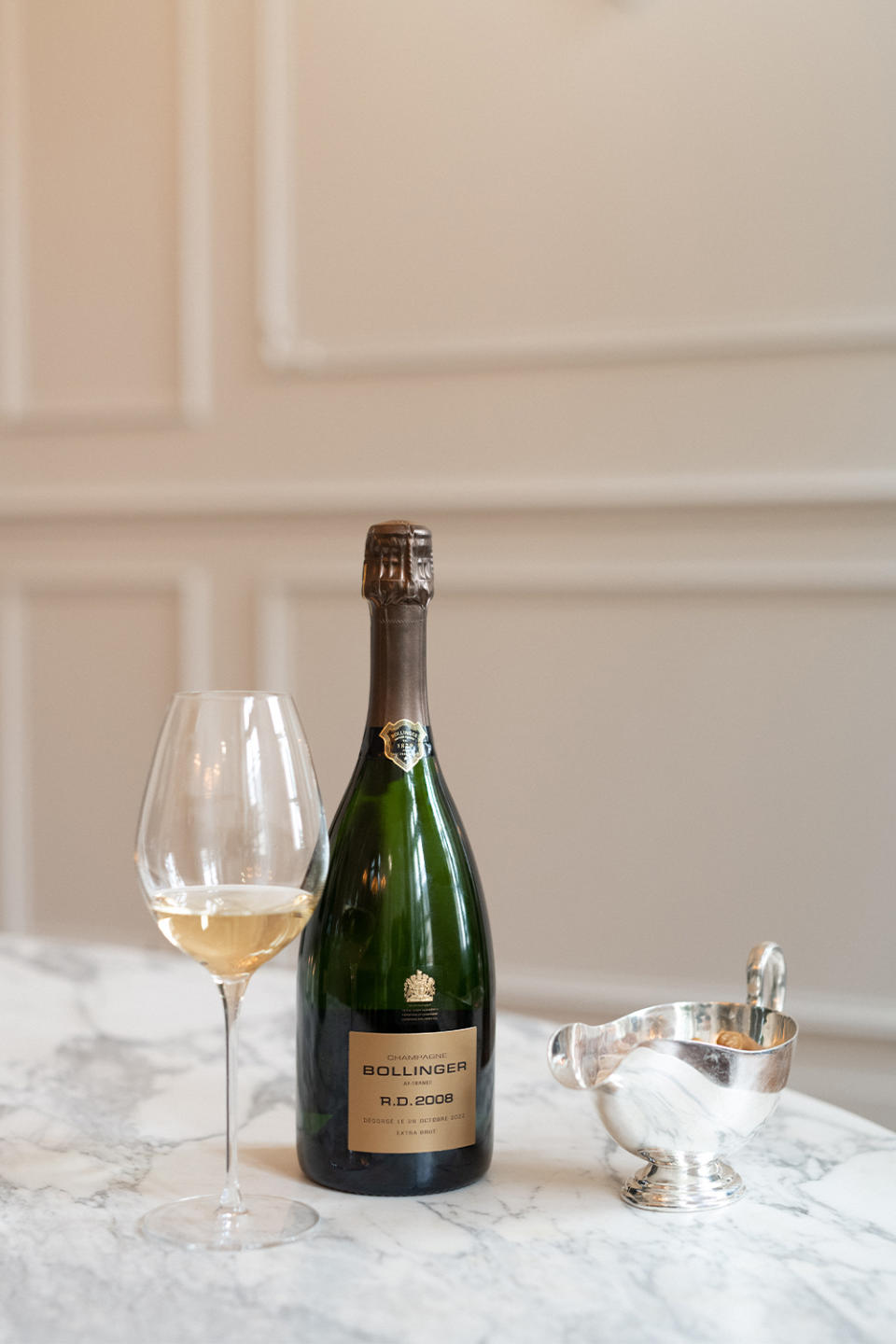Champagne Bollinger Just Released a Limited New Vintage That’s Poised to Age Beautifully

- Oops!Something went wrong.Please try again later.
Following in the footsteps of Madame Lily Bollinger, Champagne Bollinger has released its R.D., or recently disgorged, 2008 vintage. The French term récemment dégorgé refers to Champagne that has been aged in bottle on the lees for several years prior to disgorgement. Madame Bollinger, who took over the house when her husband died in 1942, is said to have developed the style in 1967, when she released a just-disgorged 1952 Champagne. Remarkable for its combination of complexity and freshness, Bollinger R.D. 2008 offers fine perlage and aromas of peach, yuzu, just-baked brioche, and slivered almonds. Lively acidity and a delicate mousse provide a backdrop for green apple, dried apricot, candied orange peel, and hazelnut flavors that culminate in a distinct saline note.
Champagne Bollinger R.D. 2008 is made with 79 percent Pinot Noir and 21 percent Chardonnay from 18 Grand Cru and Premier Cru vineyards, mainly in the communes of Ay, Verzenay, Les Mesnil-sur-Oger, and Cramant. The low dosage, 3 grams of sugar per liter, falls into the extra brut category, which enhances both the acidity and the feeling of effervescence on the palate. It was launched in Paris at the 18th century Hotel de la Marine, a museum that housed France’s naval ministry for 200 years. Presented by Bollinger chef de cave Denis Bunner and Charles-Armand de Belenet, the house’s managing director, the Champagne was poured from bottle, magnum and double magnum, paired with a lunch that featured Italian hazelnuts in each course, in homage to the notes of hazelnut the wine exhibits. As de Belenet explained, “The contrast between the freshness of the wine and the hazelnut’s generous flavor profile means that Bollinger R.D. 2008 is able to fully express its aromas and reveal itself in all its splendor.”
More from Robb Report
This Extraordinary 3,600-Bottle Wine Collection Could Fetch More Than $3.5 Million at Auction
Brad Pitt's Rosé Champagne Will Be the Oscars' Official Bubbly This Year
Some of the World's Best Sparkling Wines Are in the South of Britain. Here's Where to Find Them.

While NV (non-vintage) Champagne showcases a house style year after year, vintage Champagne, produced with grapes from a single harvest, is more complex in taste and texture thanks to aging in the bottle for several years in constant contact with the lees. It is produced in much smaller quantities than non-vintage Champagne and only in exceptional years. A long-aged R.D. is an even rarer find. Bollinger refers to its “regular” vintage Champagne as Grande Annee; Le Grande Annee 2008 was first released in 2019, with some held back to either be released a year later, also as Le Grande Annee, or at an even later date as recently disgorged. Denis Bunner told Robb Report, “Normally when we sell our Grande Annee, it lasts two years. At the end of the first year, we decide how much we will keep aside. This time, it was a little particular, and since the beginning, we noticed that this wine had a great aging potential. So we decided to sell Grande Annee for only one year and to set the remainder aside for R.D.” Although no specific numbers were given, it seems that about 30 percent of the 2008 vintage was destined for R.D., as opposed to the usual 20 percent or so.
In addition to developing the R.D. style, Madame Bollinger is also credited with returning to fermentation in wood barrels and being the first in the modern era to age Champagne in the bottle prior to disgorgement under cork rather than a metal cap, the type used on beer bottles. In addition, she was the first to put the date of disgorgement on the label; the R.D. 08 was disgorged in October 2022. Since 2008, the house also uses a bottle with a slightly narrower neck than usual, which “contributes to the maturation of the wine,” Bunner says. “We slow down the air exchange, which you will see when you taste the 08. The beautiful aromatic notes are thanks to the vintage and the work we did in the cellar, including barrel fermentation, which adds to the profile of our wine.” He added, “The 08 vintage was quite cold so we have nice acidity in addition to the minerality on the palate.”
While it is drinking very well at the moment, it will also keep its freshness and continue to develop more complex flavors for several years. To prove this point, guests were also served Bollinger R.D. 1979, which was disgorged in 1990 and has been aging in bottle since. With flavors of almond, honeycomb, almond, apple pie, and lemon, it had lively acidity and a beautiful sense of creaminess. Speaking about the R.D. 2008, which retails for $400, Bunner said, “Every 20 years you have one vintage that is above all the others, and I think that time will tell us this will be the one.”
Best of Robb Report
Why a Heritage Turkey Is the Best Thanksgiving Bird—and How to Get One
The 10 Best Wines to Pair With Steak, From Cabernet to Malbec
Sign up for Robb Report's Newsletter. For the latest news, follow us on Facebook, Twitter, and Instagram.

